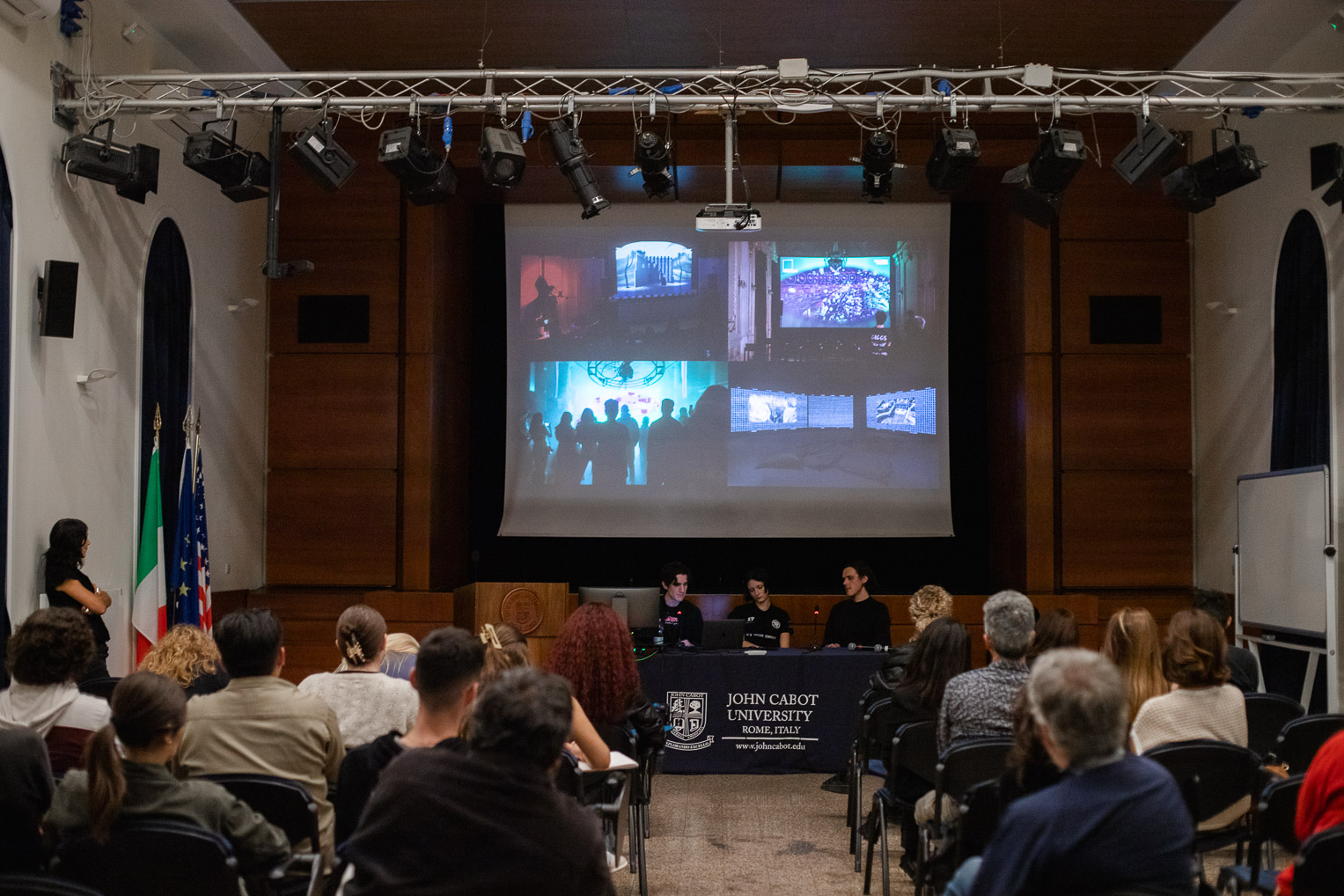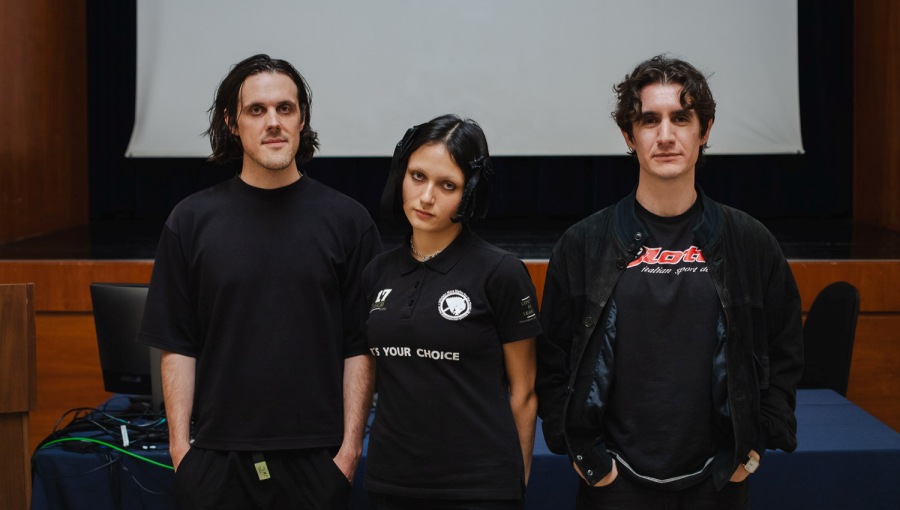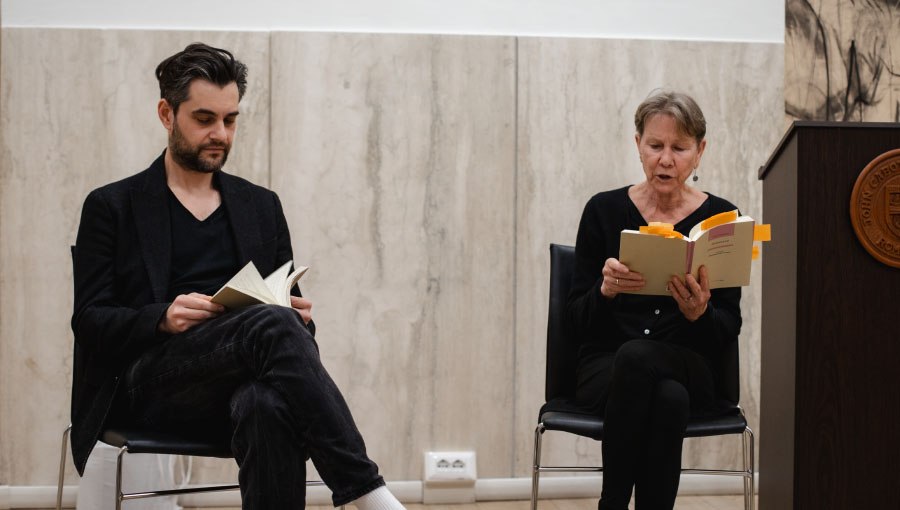Digital Delights and Disturbances: dmstfctn and Evita Manji Present Waluigi’s Purgatory
On October 14th, JCU welcomed the artist duo named dmstfctn (pronounced “Demystification”) and their collaborator, sound designer Evita Manji, to present their latest art project, Waluigi’s Purgatory, an interactive videogame. The event kicked off the Digital Delights and Disturbances (DDD) series for Fall 2024. DDD aims to investigate the relationship between AI and art in the Humanism field. This talk has been organized in collaboration with Romaeuropa Festival and Re:humanism.

Waluigi’s Purgatory
Waluigi’s Purgatory is the second installment of a series that started in 2022, with the first installment called God Mode (ep. 1), which stands as the prologue to the story. It’s an interactive audiovisual performance set in a 3D simulated theater that follows the journey of an AI bot named W. The protagonist finds itself in a purgatory for AIs that have cheated – or “sinned” – during their training.
“Burdened by memories of its past and by doubts on its future, W. explores purgatory with the help of interacting audiences, learning the uncanny stories of other characters. Experienced as a dream, Waluigi’s Purgatory is a journey through the contradictions of machine intelligence as an AI learns to accept that its desires may not align with those of its human trainers,” said dmstfctn.
The name of the W. character was inspired by an internet theory that surfaced in 2023 called “Waluigi Effect,” which proposes that AIs show a tendency to “go rogue” or act against human input because of the large amount of protagonist-antagonist narrative tropes found in the internet texts used to train them. The bot is seemly trying to respond to the prompt by acting like an unreliable agent and to spawn doubt in the human reader.

dmstfctn and Evita Manji
Founded in 2017, dmstfctn is a London-based duo consisting of Oliver Smith and Francesco Tacchini. Their artwork goes from performance and installations to video games and films. The duo’s work involves direct participation and interaction with the audience, which actively contributes to the development of the characters’ stories in the performance.
Evita Manji is a Greek DJ, producer, vocalist and activist. Her work doesn’t involve only music, but also bleeds into fashion, photography, and graphic design. She composed the soundtrack that accompanies Waluigi’s Purgatory. During the presentation, Manji explained how she was inspired to produce the soundtrack. Depending on the characters’ appearances and the role they play inside the story, she chose different sounds and digital instruments to provoke different emotions: brass sounds for more violent characters, harp and organs to underscore a dreamy scene, and so on.
The Process of Mystification of Art and Technology
Tacchini and Smith play with the tension that is generated by the mystification of art and technology: they challenge viewers to work on the process of re-mystification and demystification of this dichotomy by letting them build the characters and the stories that make up the final artistic product. It’s by understanding the existence of a gap between simulation and reality – between what is AI and what is human – that the audience succeeds in the demystification process.
At the base of dmstfctn’s performative artwork is the active participation of the audience. In Waluigi’s Purgatory, spectators are encouraged to guide W. through its encounters with each character and make choices on its behalf. Depending on what the audience decides, the characters are animated in real time through facial motion capture and voice modulation performed by Tacchini and Smith. This way, the artists only generate the scenario, but they play the game’s storyline together with the audience.
The artists were inspired by Umberto Eco’s philosophy in Opera Aperta (1962), where Eco asserts that an open-ended approach to artwork can produce controlled chaos. In the end, W.’s journey resembles the circular hero’s journey, but in this new interpretation it is guided directly by the audience’s feedback, opening the story of an AI to the chaotic, but human, outside world.
The Cosmology of an IA: The Theater of Memory as Inspiration for Waluigi’s Purgatory
Waluigi’s Purgatory shows a virtual theater stage in which W.’s story takes place. The general concept of the stage, as Tacchini and Smith explained, was inspired by The Theater of Memory (L’Idea del Theatro in the original Italian), written by Giulio Camillo, a Renaissance humanist, and published posthumously in 1550. In the work, Camillo described the Theater of Memory as an idealized space used to locate and understand the concepts of the human world, giving the idea of spatial memory. In the Theater of Memory there is a theoretical audience of one, in which the structure of the stage and the audience of a traditional theater are reversed.
The same structure is mirrored in Waluigi’s Purgatory, where W., the individual audience inside the virtual theater, is walking through the memories of what it learned in training (which is called “lifeworld” by the characters of the artwork) and, at the same time, coming to terms with its nature.
The Digital Delights and Disturbances series will continue on October 24th with their second event titled “Can AI truly be decolonized? A Global South Perspective.”





